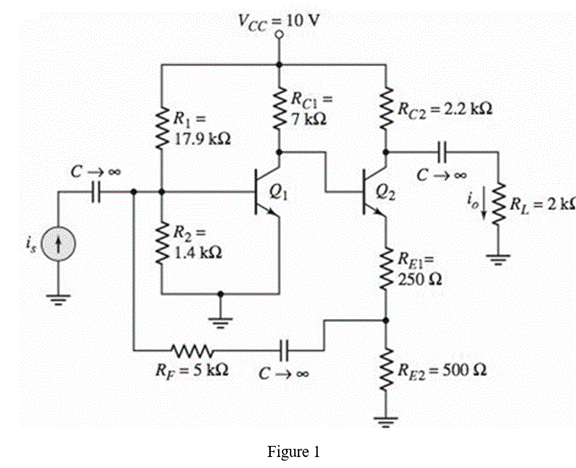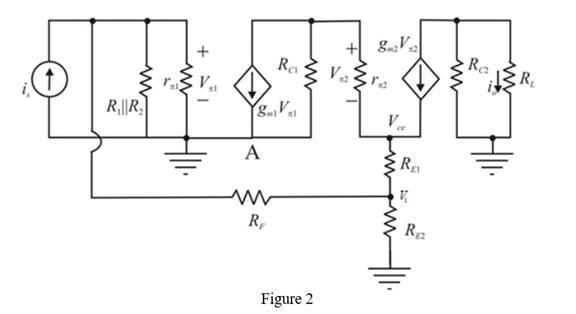
For the transistors in the circuit in Figure P 12.53, the parameters are:

The value of the closed loop current gain of the circuit.
Answer to Problem 12.53P
The value of the current gain is
Explanation of Solution
Given:
The given diagram is shown in Figure 1

Calculation:
The small signal model of the above circuit is shown below.
The required diagram is shown in Figure 2

The expression to determine the value of the Thevenin resistance of the circuit is given by,
The Thevenin voltage of the circuit is calculated as,
The expression for the base current of the first transistor is given by,
Substitute
The expression to determine the collector current of the first transistor is given by,
Substitute
The expression to determine the value of the base voltage of the second transistor is given by,
Substitute
The expression for the current
Substitute
The expression to determine the value of the collector current
Substitute
The expression for the transconductance of the first transistor is given by,
Substitute
The expression for the small signal resistance is given by,
Substitute
The expression for the transconductance of the second transistor is given by,
Substitute
The expression for the small signal resistance is given by,
Substitute
Apply KCL at source
Substitute
Apply KCL at node A.
Substitute
Apply KCL at node
Substitute
Apply KCL at
Substitute
Substitute
Substitute
Substitute
Substitute
The expression to determine the value of the output current is given by,
Substitute and
Substitute
Conclusion:
Therefore, the value of the current gain is
Want to see more full solutions like this?
Chapter 12 Solutions
Microelectronics: Circuit Analysis and Design
- The circuit of Figure below uses current- (or shunt-) feedback bias. The Si transistor has ICEO = 0, B = 100, Rc= 2k2, Vcc = 12 V. Assume that; (VCEQ = Vcc /2). A. Find the value of Ibq B. Find the value of Rf C. Find the value of Rearrow_forwardA voltage follower is to be designed to provide a gain error of less than 0.005 percent. Develop a set of minimum required specifications on open-loop gain and CMRR.arrow_forwardc) As given in the figure a clamper circuit with the input signal Vi is proposed to design. Determine the output voltage with the exact solution step by step. Sketch transfer characteristic VO versus Vi.arrow_forward
- (A) For a 5 input resistive divider ('0-0V, 1'-+15V) find i) The full-scale output voltage. ii) The output voltage change due to the LSB. iii) The analog output voltage for a digital input of 01011. (B) Design 3 bit feedback amplifier DAC.arrow_forwardCalculate the total offset voltage for the circuit shown below for op-amp specification values of input offset values, VIO=3.5 mV and IIO=73 nA with RF=20000 ohm and Rin=3000 ohm.arrow_forwardCalculate the total offset voltage for the circuit shown below for op-amp specification values of input offset values, VIO=2.8 mV and IIO=110 nA with RF=14000 ohm and Rin= 3000 ohm.arrow_forward
- a) Find the close loop transfer function of the following system through block diagram simplification b) Convert the block diagram in a) into a signal flow grapharrow_forwardChange the value of the load resistor RL. How does lowering the value of RL affect the openloop and closed loop gain and why?arrow_forwardUse the PAL with a feedback portion below to implement the following function:arrow_forward
 Introductory Circuit Analysis (13th Edition)Electrical EngineeringISBN:9780133923605Author:Robert L. BoylestadPublisher:PEARSON
Introductory Circuit Analysis (13th Edition)Electrical EngineeringISBN:9780133923605Author:Robert L. BoylestadPublisher:PEARSON Delmar's Standard Textbook Of ElectricityElectrical EngineeringISBN:9781337900348Author:Stephen L. HermanPublisher:Cengage Learning
Delmar's Standard Textbook Of ElectricityElectrical EngineeringISBN:9781337900348Author:Stephen L. HermanPublisher:Cengage Learning Programmable Logic ControllersElectrical EngineeringISBN:9780073373843Author:Frank D. PetruzellaPublisher:McGraw-Hill Education
Programmable Logic ControllersElectrical EngineeringISBN:9780073373843Author:Frank D. PetruzellaPublisher:McGraw-Hill Education Fundamentals of Electric CircuitsElectrical EngineeringISBN:9780078028229Author:Charles K Alexander, Matthew SadikuPublisher:McGraw-Hill Education
Fundamentals of Electric CircuitsElectrical EngineeringISBN:9780078028229Author:Charles K Alexander, Matthew SadikuPublisher:McGraw-Hill Education Electric Circuits. (11th Edition)Electrical EngineeringISBN:9780134746968Author:James W. Nilsson, Susan RiedelPublisher:PEARSON
Electric Circuits. (11th Edition)Electrical EngineeringISBN:9780134746968Author:James W. Nilsson, Susan RiedelPublisher:PEARSON Engineering ElectromagneticsElectrical EngineeringISBN:9780078028151Author:Hayt, William H. (william Hart), Jr, BUCK, John A.Publisher:Mcgraw-hill Education,
Engineering ElectromagneticsElectrical EngineeringISBN:9780078028151Author:Hayt, William H. (william Hart), Jr, BUCK, John A.Publisher:Mcgraw-hill Education,





